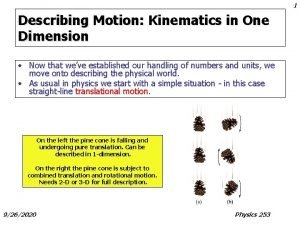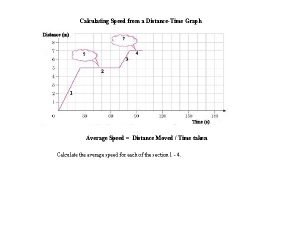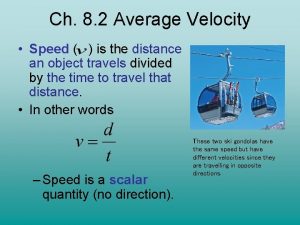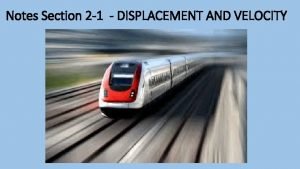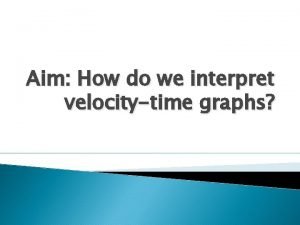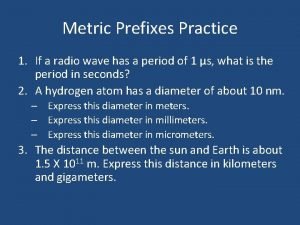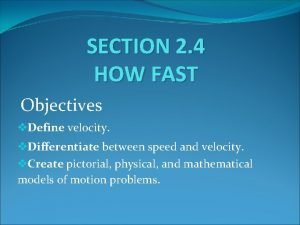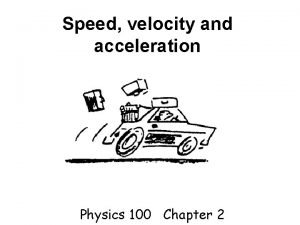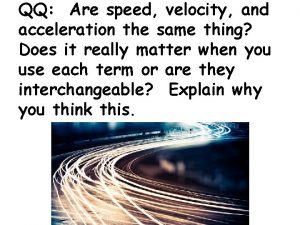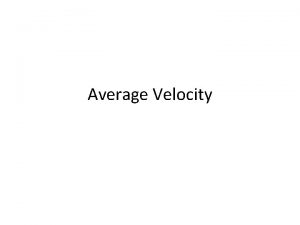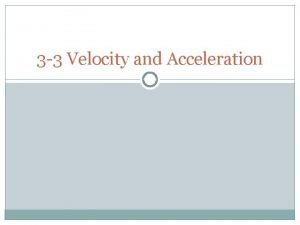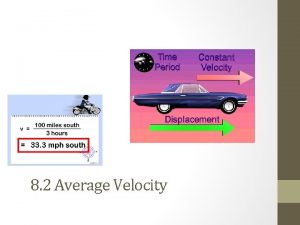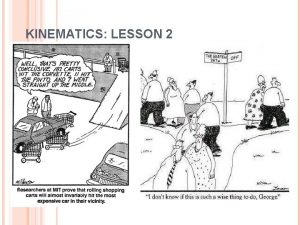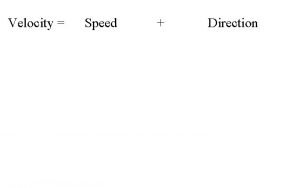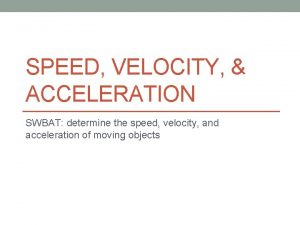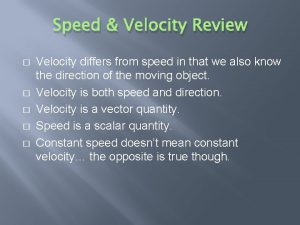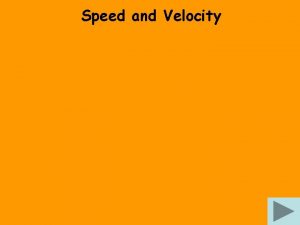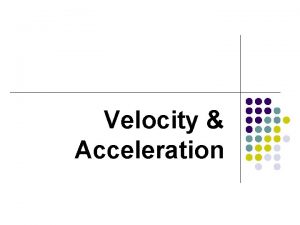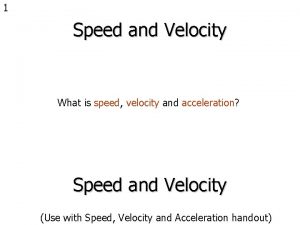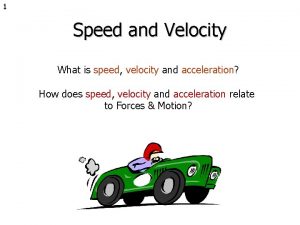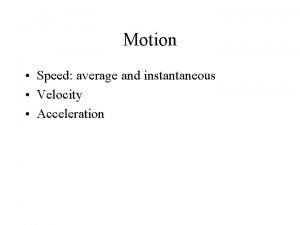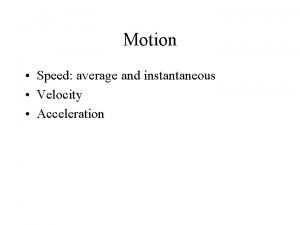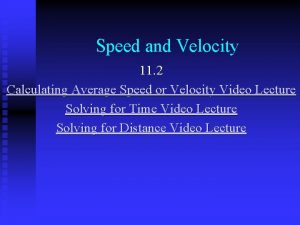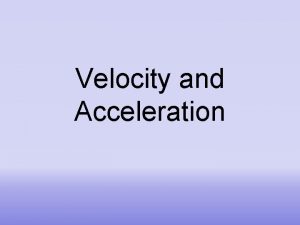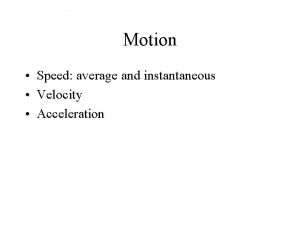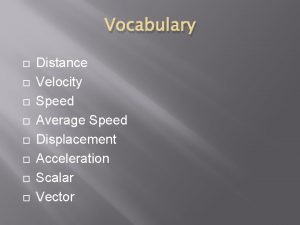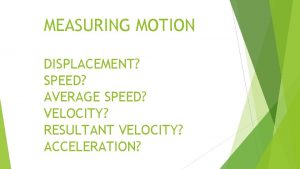Ch 8 2 Average Velocity Speed is the
























- Slides: 24

Ch. 8. 2 Average Velocity • Speed ( ) is the distance an object travels divided by the time to travel that distance. • In other words – Speed is a scalar quantity (no direction). These two ski gondolas have the same speed but have different velocities since they are travelling in opposite directions.

Provincial Exam Question

• Velocity ( ) is the displacement of an object divided by the time interval. • In other words • Velocity describes how fast an object’s position is changing. • Velocity is a vector quantity (direction). • The units for velocity and speed are metres per second (m/s).

Provincial Exam Question

Calculating the Slope of the Position-Time Graph • To learn more about velocity, we must now understand straight line graphs. • The slope of a graph is represented by – rise = change in y-axis – run = change in x-axis

Finding the Slope of a Line 3. 500 400 Position (m) 1. Pick two points on the grid. 2. Make a triangle 300 400 200 100 4. Units = metres/second So slope = 36. 4 m/s 11 0 2 4 6 8 10 Time (s) 12 14 16 18 20

Position – Time Graph • On a position-time graph the slope is the change in position ( ) divided by the change in time ( ).

Example Which jogger’s motion has a greater slope? Which jogger is moving faster? What is the slope of each line? What is each jogger’s ?

Provincial Exam Question

Average Velocity • Usually, objects do not move at a perfectly constant speed. • For this reason, we often use “average velocity” in our calculations. • The slope of a position-time graph is the object’s average velocity ( ). • Average velocity is the rate of change in position for a time interval.

Provincial Exam Question

• Remember , (average velocity), is a vector and we must therefore always include a direction. • If we were to discuss , (average speed), we do not need to include direction, because speed is a scalar.

On a position-time graph if “forward” is given a positive direction: • A positive slope means that the object’s average velocity is forward. • A negative slope means that the object’s average velocity is backwards. • Zero slope means the object’s average velocity is zero.

Calculating Average Velocity The relationship between average velocity, displacement, and time is given by: Example 1 1. What is the average velocity of a dog that takes 4. 0 s to run forward 14 m? Solution One: out known values. Step Two: Insert down values equation. into equation Step Three: Four: Write Calculate answer.

Example 2 1. A boat travels 280 m East in a time of 120 s. What is the boat’s average velocity? Solution Step Three: One: Write out known values. Two: Four: Calculate Insert down values answer. equation. into equation

Provincial Exam Question

Example 3 1. What is the displacement of a bicycle that travels 8. 0 m/s [N] for 15 s? Solution Four: Calculate answer. Step Three: Insert values into equation One: Write out known values. Two: down equation.

Example 4 Solve this problem on your own, using the same steps. 4. A person, originally at the starting line, runs west at 6. 5 m/s. What is the runner’s displacement after 12 s? Answer: 78 m West

Provincial Exam Question

Calculating Time Use the last equation to solve the following: 1. How long would it take a cat walking north at 0. 80 m/s to travel 12 m north? Solution: 2. A car is driving forward at 15 m/s. How long would it take this car to pass through an intersection that is 11 m long? Solution:

Provincial Exam Question

Converting between m/s and km/h • To convert from km/h to m/s – Change km to m: 1 km = 1000 m – Change h to s: 1 h = 3600 s • Therefore multiply by 1000 and divide by 3600 or • Divide the speed in km/h by 3. 6 to obtain the speed in m/s. For example, convert 75 km/h to m/s.

Converting between m/s and km/h Try the following unit conversion problems yourself. 1. Convert 95 km/h to m/s. • 95 km X 1000 m X 1 hr = 26 m/s 1 hr 1 km 3600 s 2. A truck’s displacement is 45 km north after driving for 1. 3 hours. What was the truck’s average velocity in km/h & m/s? Vav = 45 km 1. 3 hr = 35 km/h N or 9. 6 m/s N 3. What is the displacement of an airplane flying 480 km/h [E] during a 5. 0 min time interval? d = 480 km X. 083 hr 40 km [E] or hr 40, 000 m [E] Take the Section 8. 2 Quiz

Provincial Exam Question Take the Section 8. 2 Quiz
 Motion in straight line formula
Motion in straight line formula Instantaneous velocity vs average velocity
Instantaneous velocity vs average velocity What two measurements are necessary for calculating speed
What two measurements are necessary for calculating speed Time speed formula
Time speed formula Initial velocity and final velocity formula
Initial velocity and final velocity formula Angular velocity to tangential velocity
Angular velocity to tangential velocity Final velocity initial velocity acceleration time
Final velocity initial velocity acceleration time Angular acceleration formula
Angular acceleration formula Hydraulic conductivity of soil formula
Hydraulic conductivity of soil formula Deceleration on velocity time graph
Deceleration on velocity time graph Linear acceleration and angular acceleration
Linear acceleration and angular acceleration Derivation of darcy's law
Derivation of darcy's law How to find average velocity
How to find average velocity Average velocity over time interval
Average velocity over time interval Find displacement
Find displacement How to calculate average speed
How to calculate average speed What is the average velocity of the object
What is the average velocity of the object Simpson drives his car with an average velocity of 48
Simpson drives his car with an average velocity of 48 What is the average velocity of the skier in the image
What is the average velocity of the skier in the image Velocity function
Velocity function Relative triangles
Relative triangles Define average velocity
Define average velocity How can be
How can be Velocity and acceleration
Velocity and acceleration Are speed and acceleration the same thing
Are speed and acceleration the same thing

